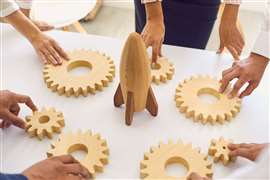Small is beautiful
15 April 2008
![]()
Compact construction machines are extremely popular in developed markets, with sales of mini excavators, skid steer loaders and compact wheeled loaders around the 200000 units per year mark at the moment across Europe, Japan and the US. This represents around 45% of the market in unit terms, although being among the smallest machines used in construction, the sector's value is much less than this - around 25% to 30% of the total.
It is a part of the industry that has grown in importance and diversified significantly over the last 10 to 15 years. Whereas building such machines may have been seen as the province of specialist manufacturers in the early 1990s, it is now a mainstream activity, with all the major international players competing. The turning point arguably came in 1998 when Caterpillar launched its first ever mini excavators and compact wheeled loaders, followed by skid steer loaders in 1999.
One of the reasons for compact machines’ popularity is the huge range of jobs they can do, thanks to the number and variety of attachments on the market.
As well as buckets, tools such as breakers, cutters, crushers, augers, pallet forks, augers, asphalt planers, sweepers, trenchers and even snow ploughs mean these machines can be used in a range of applications extending beyond the construction applications they were originally designed for.
The increasing use of hydraulic quick hitches also means that attachments can be changed easily - usually in less than a minute, and by just one person. This means compact machines can switch quickly between different jobs on site, further improving their versatility.
But while the popularity of compact machines has grown immensely among contractors and rental companies in the developed world, they are still a rare sight in many emerging markets.
The main reason for this is that compact machines compete with manual labour. In the developed world, wages are relatively high, and the need to build quickly tends to favour mechanisation. In contrast, emerging markets often have excess cheap labour, sometimes to the extent that compact equipment is frowned upon, because it is seen as taking jobs from manual workers.
Having said that, economic growth has picked up around the world over the last few years, pushing up wages for manual workers. In addition, the need for faster construction to maintain the pace of growth has stimulated the compact equipment market. One of the most striking examples is China - at the start of the decade the market for mini excavators was almost non-existent. Now it is well over 10000 machines per year, and, according to Off-Highway Research, is set to continue its remarkable growth for the foreseeable future.
When compact equipment is bought in the developing world, the fact that it is competing against cheap manual labour tends to mean the machines have to work harder to justify the investment. According to Volvo, compact machines in developing markets work +40% more hours than their North American or European counterparts. Typically this means 2500 hours per year - a 48 hour week - compared to 1500 hours (just under a 30 hour week) in developed areas.
What is compact equipment?
It is a little difficult to define precisely what constitutes a piece of compact equipment, The main product groups are compact excavators (up to about 5 tonnes operating weight), skid steer loaders - they can weigh as much as 4 tonnes, with lifting capacities to about 1.3 tonnes - and compact wheeled loaders - machines up to about 60 kW engine power with up to 1 m3 buckets. Compact wheeled loaders often feature an articulated frame to improve their manoeuvrability on site.
In addition to these machines, which have traditionally defined the sector, recent years have seen some new variants. For example, most skid steer loader manufacturers now market one or two tracked variants - essentially the same upper structure mounted on a dozer-style tracked undercarriage rather than wheels.
A little further back in the mid- to late-1990s the first reduced and zero tail swing mini excavators began to emerge from Japan. As the names suggest, these models have shortened counterweights and in the case of zero tail swing machines, the excavator body does not extend beyond the footprint of the tracks.
New machines
As one might expect, this month's Bauma exhibition will see the launch of numerous new machines. By iC's reckoning, there will be at least 50 new mini excavators, skid steer loaders and compact tracked and wheeled loaders launched at the exhibition by the world's major manufacturers.
In the mini excavator segment the European preference for zero and short-radius machines is evidenced by the fact that almost all the new machine launches in the sub-5 tonne excavator category this year are reduced or zero-radius machines. It has taken about 10 years from the first zero tail swing machines being introduced in Europe to the point today where their popularity heavily outweighs traditionally designed machines with an overhanging counterweight.
Having said that, many of the major manufacturers only added their first short radius minis in recent years. One example, surprisingly, is compact equipment specialist Bobcat, which introduced its first zero tail swing excavator, the 3.6 tonne 430 ZHS, as recently as late 2003. It has since been joined by the 4.7 tonne 435 ZHS, and Bauma will see the addition of the 2.6 tonne 425 ZTS and 2.9 tonne 428 ZTS, for a fuller range.
All four models feature load sensing hydraulics, while an interesting feature initially developed for the 430 is Bobcat's FastTrack option. This replaces the conventional track drive with a hydrostatic drive which increases the travel speed from the normal 4.2 km/h - around walking speed - to 8 km/h or more.
Bobcat also offers larger zero radius models in the shape of the 7.5 tonne 442 and a 12.5 tonne short radius model, the 444. These are supplied to it by Terex under an OEM supply agreement.
Volvo also has a four-model range of short tail swing excavators, and it is interesting to note that this is one of the companies that classifies machines as big as its 8.5 tonne ECR 88 model as ‘compact’. Bauma will see it introduce upgraded versions of two of these, the ECR 58 Plus and ECR 88 Plus, which weigh in at 5.5 and 8.5 tonnes respectively, and feature heavier counterweights for improved lifting capacities.
The latest manufacturers to enter the zero tail swing sector are the two Koreans, Doosan Infracore and Hyundai. Both will move into the market with machines in the popular 3.5 tonne class at Bauma - Doosan's is the DX35Z, while Hyundai's is the R35Z-7. The latter comes with a 0.11 m3 bucket as standard and offers a maximum digging depth of 3.15 m, while it has a dump height of 3.46 m.
Finding the fullest ranges of compact excavators in general, including short tail swing models, tends to mean looking at Japan's leading manufacturers - Japan, after all was the region where the concept was established.
These machines are available in different guises, because of all the major Japanese equipment manufacturers, only Komatsu is active in all the major regions of the world with all its products under its own brand. Others, such as Hitachi and Kobelco have a partial presence, but in certain territories supply partners - John Deere in Hitachi's case and CNH in Kobelco's - with mini excavators, rather than selling them in their own colours.
The three new additions to Hitachi's compact line-up at Bauma are all short tail machines, the 1.1 tonne ZX10U-2, 1.7 tonne ZX17U-2 and 2.3 tonne ZX22U-2. Changes to the counterweights improve stability, while the cabs have been improved with more legroom, better visibility and air conditioning. Some of these are already available in the Americas from John Deere. The ZX17U-2 for example is marketed as Deere's 17D.
Similarly, New Holland's new 1.6 tonne E18 SR will be marketed in Asia by its designer Kobelco as an SK-designated machine. This short radius excavator features an undercarriage whose width can be adjusted hydraulically from 0.99 to 1.3 m. This allows it to get into tight spaces when the undercarriage is reduced, while widening the gauge gives the E18 SR more stability when digging. Several manufacturers besides Kobelco/New Holland offer this on 1 and 1.5 tonne mini excavators.
Other new machines at Bauma include Amman-Yanmar's 1.68 tonne ViO17, 4.64 tonne ViO45 and 5.21 tonne ViO55. According to Ammann-Yanmar, which is a joint venture between Japanese compact specialist Yanmar and Switzerland's asphalt and concrete equipment manufacturer Ammann, the larger machines feature a wealth of design improvements, such as better hose routing and cylinder protection, a bigger dozer blade and the option of a quick coupler.
Ihimer, a similar joint venture between Japan's IHI and Italy's Imer will be adding two 5 tonne class mini excavators to fill gaps in its 12-model range. The 50VX and 55VX are both zero tail swing models weighing in at 4.8 and 5.3 tonnes.
New from Hanix Europe, a subsidiary of Japan's Nagano, is the similarly sized 5.5 tonne H55DR. The machine features a large, more comfortable cab than its predecessor, and the control layout has been changed for easier operation. Floating mounts mean the operator is better isolated from noise and vibration, and there is more glass for better visibility.
Skid steers
North America accounts for more than 75% of the world market of about 70000 skid steer loaders per year, and these machines are used widely in agriculture as well as construction. The global market is understandably dominated by US manufacturers, and it is therefore likely that there will be a big wave of new machine launches at next March's ConExpo show in Las Vegas, Nevada.
Having said that, there are some interesting new machines coming out at Bauma, among them the compact S100 from Bobcat. Weighing in at just 1.8 tonnes it has a rated capacity of 453 kg. At 2.26 m long and 1.18 m wide the S100 can manoeuvre in confined spaces, while a selection of more than 30 attachments means it can carry out a range of tasks.
Further up the weight categories is New Holland's 900 kg capacity L175. It features the company's ‘Super Boom’ vertical lift linkage for higher dump heights, fast ground speeds and the design means there are no rear towers or structures to reduce visibility. Options include two-speed drive and a deluxe cab with air conditioning.
JCB will be unveiling new machines in its ‘Robot’ skid steer loader range. The line-up consists of five wheeled skid steers from 600 kg to 1100 kg capacity, along with three tracked variants boasting 820, 900 and 1020 kg capacities. While most of these machines are replacements for existing models, the (wheeled) Robot 180 is JCB's first ever 800 kg capacity skid steer.
The most striking thing about JCB's skid steers is the single arm design, which allows the operator to get into the cab via a side door, rather than having to climb over the bucket. Models from the 190 upwards are available as a ‘high flow’ (HF) variant to allow them to work with attachments such as planers and trencher blades.
Tracked loaders are a relatively new addition to the compact equipment market, with the first models appearing only about five years ago. By taking a skid steer loader upper and replacing the wheels with a dozer-style track, these machines exert much less pressure on the ground. This has opened the door to new applications, such as working on marshland - conditions in which a conventional wheeled machine might sink - or on surfaces such as soft turf, where normal skid steering machines might damage the ground when turning.
The new Case compact tracked skid steer for example, the 440CT, has a ground pressure of just 34.5 kPA on its 1.44 m long tracks. CNH sister company New Holland's latest models are the C175 and C185, which feature a two speed transmission for a top speed of 7.4 km/h.
Wheeled loaders
While skid steer loaders are unequivocally American in their origins, compact wheeled loaders have a split heritage, with both European and Japanese contractors favouring this type of machine in certain circumstances. At about 7000 units per year, Japan is the biggest single country in world as far as compact wheeled loader sales are concerned, but total European sales are greater at about 12000 machines, and Germany rivals Japan with its annual demand of 5500 to 6000 machines.
Given their popularity in Germany, it will come as no surprise that Bauma is set to see some significant new compact wheeled loaders launched. The Neuson Group's Kramer subsidiary is extending its 50 series of compact wheeled loaders with the 250 and 350 models. These 0.25 and 0.35 m3 bucket class machines have rigid frames and four wheel steering, and at a width of just 1.2 m, are suitable for confined sites.
Case meanwhile will introduce the E Series compact wheeled loader range, made up of the 21E, 121E, 221E and 321E with dump heights from 2.53 to 2.65 m. A key feature is the new one-piece loader front end that provides the operator with superior visibility to the coupler and attachments to allow faster attachment changes and precise working.
Mecalac will be exhibiting three new AX series compact wheeled loaders from its German subsidiary Ahlmann. Like Case's new loaders, these will follow a trend originally set by Caterpillar for a mono-boom front end. The models on show will be the AX70 AX85 and AX 100, with 0.70, 0.85 and 1 m3buckets respectively.
Developing potential
The sheer number of new machines being launched this month at Bauma underlines the huge popularity of compact equipment in regions like Europe. For the short term, the potential for increasing unemployment and the barriers of low manual labour costs are likely to mean compacts remain small volume machines in the developing world. However, China illustrates how quickly things can change when both wages rise and tighter time constraints become more important on projects.




